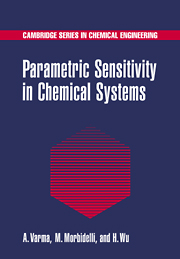Book contents
- Frontmatter
- Contents
- Preface
- 1 Introduction
- 2 Introduction to Sensitivity Analysis
- 3 Thermal Explosion in Batch Reactors
- 4 Runaway in Tubular Reactors
- 5 Parametric Sensitivity in Continuous-Flow Stirred Tank Reactors
- 6 Runaway in Fixed-Bed Catalytic Reactors
- 7 Parametric Sensitivity and Ignition Phenomena in Combustion Systems
- 8 Sensitivity Analysis in Mechanistic Study and Model Reduction
- 9 Sensitivity Analysis in Air Pollution
- 10 Sensitivity Analysis in Metabolic Processes
- Author Index
- Subject Index
6 - Runaway in Fixed-Bed Catalytic Reactors
Published online by Cambridge University Press: 04 May 2010
- Frontmatter
- Contents
- Preface
- 1 Introduction
- 2 Introduction to Sensitivity Analysis
- 3 Thermal Explosion in Batch Reactors
- 4 Runaway in Tubular Reactors
- 5 Parametric Sensitivity in Continuous-Flow Stirred Tank Reactors
- 6 Runaway in Fixed-Bed Catalytic Reactors
- 7 Parametric Sensitivity and Ignition Phenomena in Combustion Systems
- 8 Sensitivity Analysis in Mechanistic Study and Model Reduction
- 9 Sensitivity Analysis in Air Pollution
- 10 Sensitivity Analysis in Metabolic Processes
- Author Index
- Subject Index
Summary
Fixed-bed catalytic reactors consist of single tubes or bundles of tubes, packed with catalyst particles. They can be simulated by using the pseudo-homogeneous model where interparticle and intraparticle mass and heat transport resistances are neglected. The reactor runaway behavior predicted by this model has been discussed in Chapter 4. However, this simple model can be confidently applied to simulate catalytic reactors only for slow reactions. In most cases of practical interest, catalytic reactions are relatively fast and the roles of interparticle and intraparticle transport resistances have to be considered in the simulations. Thus, in the present chapter, the parametric sensitivity behavior of fixed-bed catalytic reactors is investigated by using a heterogeneous model, where both interparticle and intraparticle mass and heat transport resistances are included.
In a heterogeneous catalytic reactor, the temperature inside the catalyst particle is the key variable to be controlled, since it affects the reaction rate as well as the catalyst activity, selectivity, and life. Runaway of the particle temperature may occur because the fluid temperature is running away and the particle temperature simply follows it. This is the same phenomenon as in homogeneous tubular reactors discussed in Chapter 4. In this chapter we also account for the runaway of the particle temperature, which is strictly related to the heterogeneous nature of the system and is governed by the interaction between interparticle and intraparticle mass and heat transport and the chemical reactions.
Two approaches have been typically adopted to investigate the runaway behavior of the particle temperature. In the first, proposed by McGreavy and Adderley (1973), a single catalyst particle is extracted from the reactor and the temperature runaway behavior of this isolated particle is investigated.
- Type
- Chapter
- Information
- Parametric Sensitivity in Chemical Systems , pp. 169 - 219Publisher: Cambridge University PressPrint publication year: 1999



